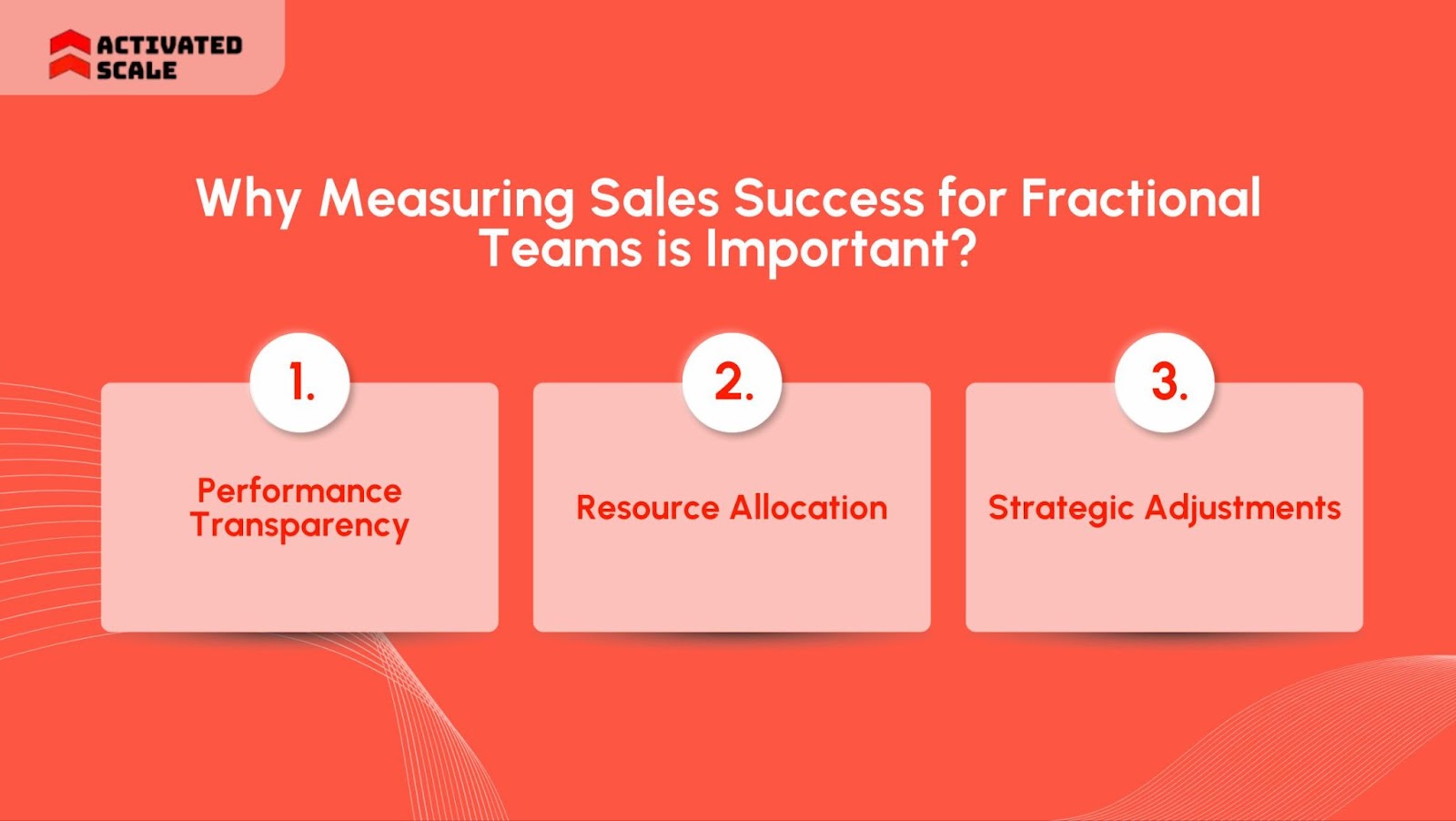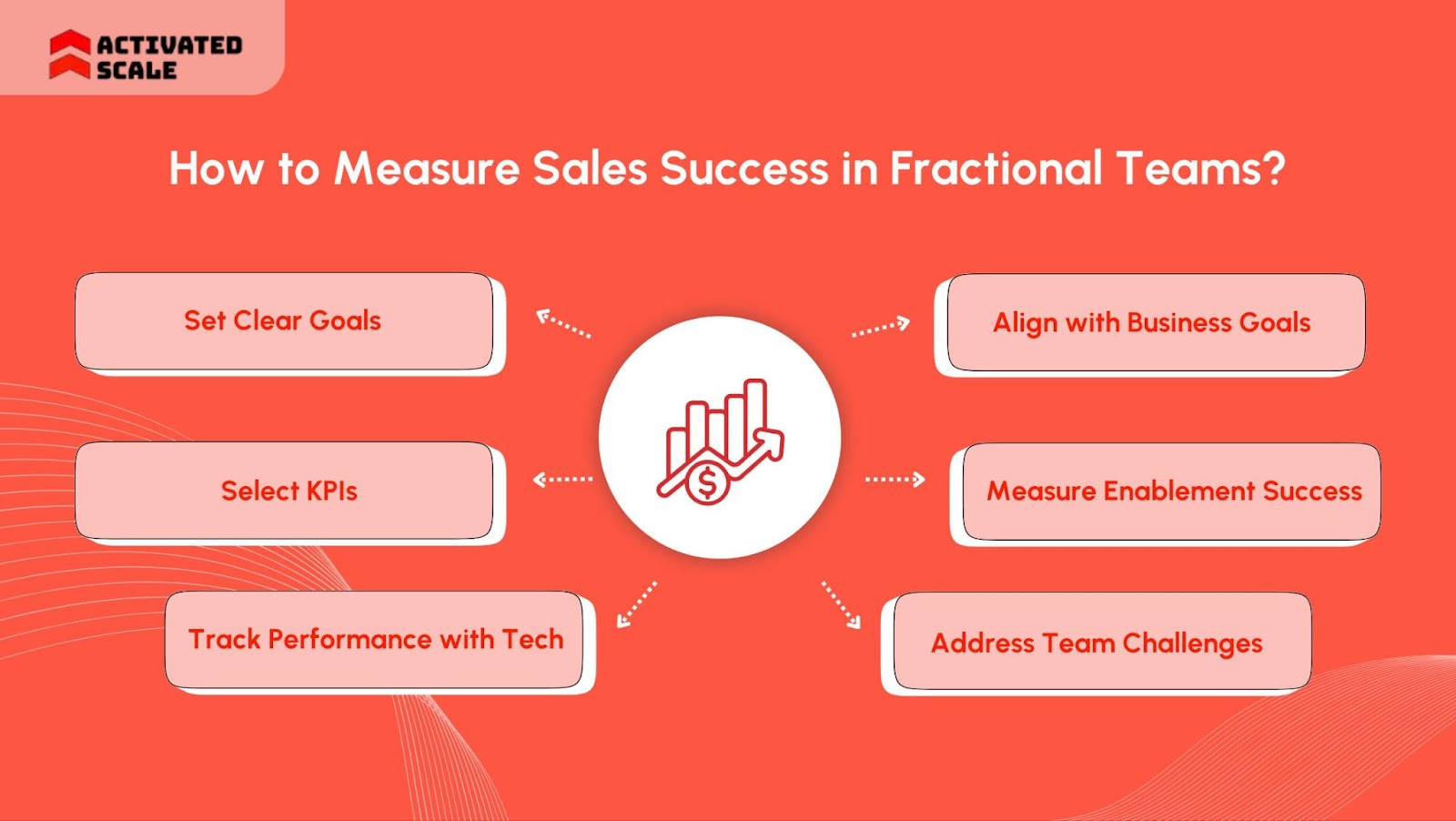As a sales leader, you might be asking yourself: "How do I accurately measure the performance of my fractional sales team? Can I rely on traditional metrics, or is something more customized needed?"
67% of full-time sales reps don’t expect to meet their quota. That is why the increasing shift toward flexible sales models has led to an uptick in fractional teams. However, tracking their success can be tricky. You need reliable data to assess whether these teams are contributing to the business’s overall growth.
In this blog, we'll walk you through how to measure sales success in fractional teams, which gives you clear insights. If you’re feeling uncertain about how to gauge the effectiveness of a team that isn’t always present, you’re in the right place.
At a Glance
- Setting clear, measurable goals and tracking relevant KPIs keeps fractional sales teams aligned with business objectives.
- CRM tools and sales analytics platforms provide real-time insights to make data-driven decisions.
- Aligning fractional teams with company goals through clear communication and training enhances their effectiveness.
- Regular performance monitoring and feedback help optimize strategies and ensure accountability.
What is a Fractional Sales Team?
A fractional sales team refers to a group of sales professionals who work part-time, on a contract basis. They are outsourced experts and typically hired to fill specific gaps in a business’s sales process. Fractional sales talent provides flexibility and specialized expertise without the long-term commitment of full-time staff.
Fractional teams can include:
- Sales Development Representatives (SDRs): Individuals focused on prospecting, qualifying leads, and generating new business opportunities.
- Account Executives (AEs): Sales professionals who handle the closing of deals and manage relationships.
- Sales Leaders: These can be fractional vice presidents (VPs) of Sales who help develop strategies on a temporary basis.
Since fractional teams bring immense value to businesses, it’s important to measure their success. In this way, you’ll know whether they need further support to bring more revenue to the company.
Read Also: Hire Fractional AE: The Ultimate Guide for Businesses
Why Measuring Sales Success for Fractional Teams is Important?

Many sales leaders face difficulties in tracking performance when working with fractional or remote teams. This struggle is particularly challenging when team members are not full-time employees. So, why does measuring sales success for fractional teams matter?
- Performance Transparency: Clear metrics help you identify areas of improvement and reward top performers.
- Resource Allocation: Accurate tracking helps you allocate resources where they will be most effective for the fractional team.
- Strategic Adjustments: When you measure performance, you gain insights to adjust strategies quickly and improve overall sales processes.
If you're looking to add the right expertise to your sales team without the full-time commitment, Activated Scale’s Fractional Selling service can help. We provide experienced SDRs and AEs to bridge the gaps in your sales process.
With this in mind, let's explore how to measure sales success in fractional teams by focusing on the right KPIs.
How to Measure Sales Success in Fractional Teams?

To truly evaluate your fractional team’s performance, it’s crucial to use the right metrics. Since fractional teams may not be involved as full-time teams, measuring success requires a more strategic approach.
When evaluating fractional teams, consider the following key factors:
1. Set Clear Goals and Expectations
You first need to establish clear, achievable goals. Without these, you risk measuring the wrong things or not having a point of comparison for success. Make sure these goals are aligned with the broader objectives of the business.
- Agree on Key Performance Indicators (KPIs): Decide on which KPIs will be used to evaluate success, such as win rates or conversion rates. These should be measurable and clearly understood by the fractional team.
- Timeframes and Deadlines: For fractional teams, it’s critical to set deadlines for specific tasks or goals. This helps prevent any ambiguity about performance expectations and makes tracking easier.
2. Choose the Right KPIs for Fractional Sales Teams
A strong KPI strategy focuses on both activity and outcomes. Here are 10 essential KPIs for fractional sales teams:
- Revenue Growth: The most direct indicator of sales success. Measures whether the team is contributing to top-line growth.
- Conversion Rate: This metric measures the percentage of leads that turn into sales. Crucial for evaluating the effectiveness of outreach.
- Lead-to-Opportunity Ratio: Tracks how many qualified leads are successfully converted into opportunities.
- Sales Cycle Length: Measures the average time it takes for a lead to convert into a customer. Shorter cycles typically indicate higher efficiency.
- Win Rate: The percentage of deals closed versus the total number of opportunities. A key indicator of how well the team is performing.
- Average Deal Size: Shows how large the sales are on average, providing insight into the quality of the deals being closed.
- Quota Attainment: Percentage of the sales target achieved, directly linking the team’s performance to business goals.
- Sales Velocity: Measures the speed at which opportunities move through the pipeline. A high velocity indicates a healthy and efficient sales process.
- Customer Acquisition Cost (CAC): The cost to acquire each customer. A higher-than-expected CAC might signal inefficiencies in the sales process.
- Customer Retention: Measures the success of post-sales efforts. High retention rates reflect well on the sales team's quality of customer relationships.
3. Use Technology to Track Performance
With fractional teams often working remotely, having automated systems in place helps organize performance tracking. Popular tools are:
- Customer Relationship Management (CRM) Tools: Systems like Salesforce and Pipedrive are key to tracking performance. These platforms offer dashboards that allow you to monitor individual and team activities. They provide clear visibility into metrics.
- Sales Analytics Platforms: Tools like Highspot and Mindtickle allow you to track content engagement, rep performance, and sales enablement metrics. This helps identify whether fractional teams are using the training provided to close deals.
- Real-Time Feedback: With automated tracking and analytics, you can provide immediate feedback to fractional sales teams. Automation in reporting can increase productivity by 14.5%. This allows for quicker adjustments, ensuring they stay aligned with goals and objectives.
4. Align Fractional Sales Teams with Business Goals
For fractional sales teams to contribute effectively, they need to be aligned with the broader business strategy. Only 16% of employees can clearly understand the company’s goal. That’s why clear communication is required to achieve company objectives.
- Onboarding and Training: Fractional teams should receive customized onboarding and training, so they understand your company’s products. Providing clear guidelines will help them get up to speed quickly and perform at their best.
- Regular Updates: Keep fractional teams informed about any changes in strategy or sales tactics. Frequent communication helps maintain alignment and ensures they remain focused on the right objectives.
- Specific Market Focus: If your fractional team is focused on a particular product line, be clear about these targets.
To support you with business goals, Activated Scale’s Fractional Sales Leadership service can provide experienced sales leaders. Let us help you create a strong, cohesive sales team that performs at its best.
5. Measure Sales Enablement Success
Sales enablement plays a critical role in supporting fractional sales teams. Measuring the enablement efforts helps determine if the team is equipped to succeed.
- Content Usage: Track how often and how effectively the fractional team uses sales content, presentations, and tools provided to them. Tools like Highspot can help you analyze content engagement and ensure your team is using the right resources.
- Training Impact: Measure how well fractional team members are retaining the training provided to them. Tools like Mindtickle can help assess knowledge retention and apply learning to real sales scenarios.
- Performance Post-Enablement: Assess how performance improves after specific enablement activities, such as new content rollouts. If a training program or resource is successful, you should see measurable improvements in KPIs.
6. Adjust for Challenges Unique to Fractional Teams
Managing fractional sales teams comes with its own set of challenges, such as varying work hours, remote setups, and communication barriers. These factors require a strategic approach to performance measurement and team management.
- Time Zone and Availability: When fractional teams are spread across different time zones, tracking performance can be difficult. Even a one-hour time gap can create a big difference. Consider adjusting KPIs based on availability and working hours.
Recognizing and addressing these challenges early on allows you to make adjustments that enhance the performance of your fractional team.
If you're facing these challenges and looking for a more flexible solution, Activated Scale’s Contract-to-Hire Sales Recruiting service can help. With our service, you get the flexibility of fractional teams with the certainty of the right hire.
Final Thoughts
Measuring the success of fractional sales teams is key to driving consistent growth. However, as we’ve seen, fractional teams come with their own unique challenges, like maintaining accountability. With the right tools and a clear approach to monitoring success, you can change these issues into opportunities for growth.
To meet your sales needs from day one, Activated Scale’s service provides you with vetted professionals on a trial basis. We offer a flexible, risk-free way to build a high-performing sales team.
Ready to find the right sales talent for your team? Book a call with us today and let’s discuss how we can help you build the ideal sales team.
FAQs
1. What are the 5 Key Performance Indicators in Sales?
The 5 key performance indicators (KPIs) in sales are:
- Revenue Growth: Measures the increase in sales revenue over a specific period.
- Conversion Rate: Tracks the percentage of leads that convert into customers.
- Average Deal Size: Represents the average value of deals closed in a given period.
- Sales Cycle Length: Measures how long it takes to convert a lead into a paying customer.
- Quota Attainment: Tracks how much of the sales target has been met by the team.
2. How can I improve the sales conversion rate for my fractional team?
Improving the sales conversion rate for a fractional sales team involves several strategies:
- Clear Communication: Regularly align your fractional team with business goals and sales strategies.
- Training and Enablement: Provide targeted training and sales resources to ensure they have the tools to convert leads effectively.
- Optimized Sales Process: It focuses on optimizing the buyer’s journey, from the first contact to closing the deal.
- Data-Driven Insights: Use CRM tools to analyze past conversion data and identify areas for improvement.
3. What are the best KPIs to track for a remote or fractional sales team?
For a remote or fractional sales team, focus on these key KPIs:
- Lead Response Time: The speed at which fractional team members respond to leads.
- Win Rate: The percentage of opportunities that get closed by the fractional team.
- Sales Cycle Length: How long it takes for a deal to move through the pipeline.
- Revenue Growth: The impact fractional teams have on the overall sales revenue.
- Quota Attainment: How much of the sales target is being achieved.
These KPIs give you a holistic view of how your fractional team is performing.
4. How do I effectively onboard fractional sales reps?
Effective onboarding for fractional sales reps can be achieved by:
- Clear Role Definition: Make sure the sales rep understands their role and what they are expected to deliver.
- Comprehensive Training: Provide specific training on your products, sales processes, and any tools or systems they’ll use (like CRM or sales enablement platforms).
- Set Expectations Early: Establish KPIs, performance metrics, and timelines from day one.
- Ongoing Support and Feedback: Regular check-ins help fractional team members stay aligned with your business goals and give them the support they need to succeed
The Ultimate Guide to Hiring a Salesperson!
Get the step-by-step guide to hiring, onboarding, and ensuring success!
_edi.png)




